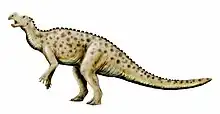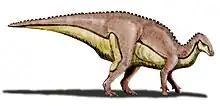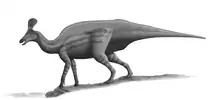| Lambeosaurines Temporal range: Late Cretaceous,[1] | |
|---|---|
 | |
| Skeleton of Parasaurolophus walkeri, Museum of Evolution Warsaw | |
| Scientific classification | |
| Domain: | Eukaryota |
| Kingdom: | Animalia |
| Phylum: | Chordata |
| Clade: | Dinosauria |
| Clade: | †Ornithischia |
| Clade: | †Ornithopoda |
| Family: | †Hadrosauridae |
| Clade: | †Euhadrosauria |
| Subfamily: | †Lambeosaurinae Parks, 1923 |
| Type species | |
| †Lambeosaurus lambei Parks, 1923 | |
| Subgroups | |
| |
| Synonyms | |
| |
Lambeosaurinae is a group of crested hadrosaurid dinosaurs.
Classification

Lambeosaurines have been traditionally split into the tribes or clades Parasaurolophini (Parasaurolophus, Charonosaurus, others (?).) and Lambeosaurini (Corythosaurus, Hypacrosaurus, Lambeosaurus, others.).[2] Corythosaurini (synonym of Lambeosaurini, see below) and Parasaurolophini as terms entered the formal literature in Evans and Reisz's 2007 redescription of Lambeosaurus magnicristatus. Corythosaurini was defined as all taxa more closely related to Corythosaurus casuarius than to Parasaurolophus walkeri, and Parasaurolophini as all those taxa closer to P. walkeri than to C. casuarius. In this study, Charonosaurus and Parasaurolophus are parasaurolophins, and Corythosaurus, Hypacrosaurus, Lambeosaurus, Nipponosaurus, and Olorotitan are corythosaurins.[3] However, later researchers pointed out that due to the rules of priority set forth by the ICZN, Any tribe containing Lambeosaurus is properly named Lambeosaurini, and that therefore the name "Corythosaurini" is a junior synonym, and the definition had Corythosaurus casuarius changed to Lambeosaurus lambei, and the same for Parasaurolophini.[4] In more recent years Tsintaosaurini (Tsintaosaurus + Pararhabdodon) and Aralosaurini (Aralosaurus + Canardia) have also emerged.[5]
Phylogeny
The following cladogram was recovered in a 2022 phylogenetic analysis by Xing Hai, and colleagues.[6]
| |||||||||||||||||||||||||||||||||||||||||||||||||||||||||||||||||||||||||||||||||||||||||||||||||||||||||||||||||||||||||||||||||||||||||||||||||||||||||||||
See also
References
- ↑ Holtz, Thomas R. Jr. (2012) Dinosaurs: The Most Complete, Up-to-Date Encyclopedia for Dinosaur Lovers of All Ages, Winter 2011 Appendix.
- ↑ Glut, Donald F. (1997). Dinosaurs: The Encyclopedia. Jefferson, North Carolina: McFarland & Co. p. 69. ISBN 0-89950-917-7.
- ↑ Evans, David C.; Reisz, Robert R. (2007). "Anatomy and relationships of Lambeosaurus magnicristatus, a crested hadrosaurid dinosaur (Ornithischia) from the Dinosaur Park Formation, Alberta". Journal of Vertebrate Paleontology. 27 (2): 373–393. doi:10.1671/0272-4634(2007)27[373:AAROLM]2.0.CO;2. S2CID 86070917.
- ↑ Sullivan, R., Jasinsky, S.E., Guenther, M. and Lucas, S.G. (2009). "The first lambeosaurin (Dinosauria, Hadrosauridae, Lambeosaurinae) from the Upper Cretaceous Ojo Alamo Formation (Naashoibito Member), San Juan Basin, New Mexico." New Mexico Museum of Natural History and Science Bulletin, 53: 405-417.
- ↑ Prieto-Márquez, Albert; Dalla Vecchia, Fabio M.; Gaete, Rodrigo; Galobart, Àngel (2013). "Diversity, Relationships, and Biogeography of the Lambeosaurine Dinosaurs from the European Archipelago, with Description of the New Aralosaurin Canardia garonnensis". PLOS ONE. 8 (7): e69835. doi:10.1371/journal.pone.0069835. PMC 3724916. PMID 23922815.
- ↑ Xing, Hai; Gu, Wei; Hai, Shulin; Yu, Tingxiang; Han, Dong; Zhang, Yuguang; Zhang, Shujun (2022). "Osteological and taxonomic reassessments of Sahaliyania elunchunorum (Dinosauria, Hadrosauridae) from the Upper Cretaceous Yuliangzi Formation, northeast China". Journal of Vertebrate Paleontology. 41 (6): e2085111. doi:10.1080/02724634.2021.2085111. S2CID 250463301.







